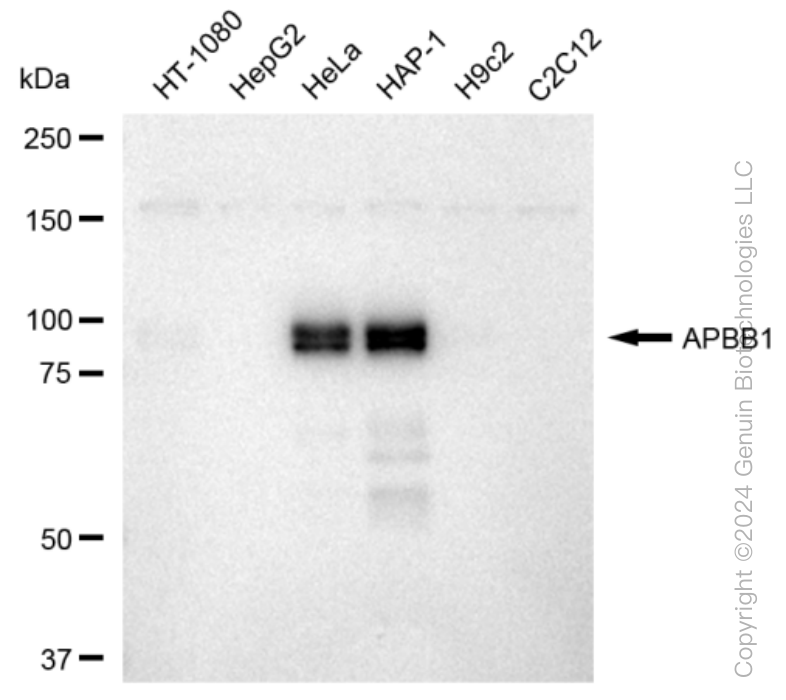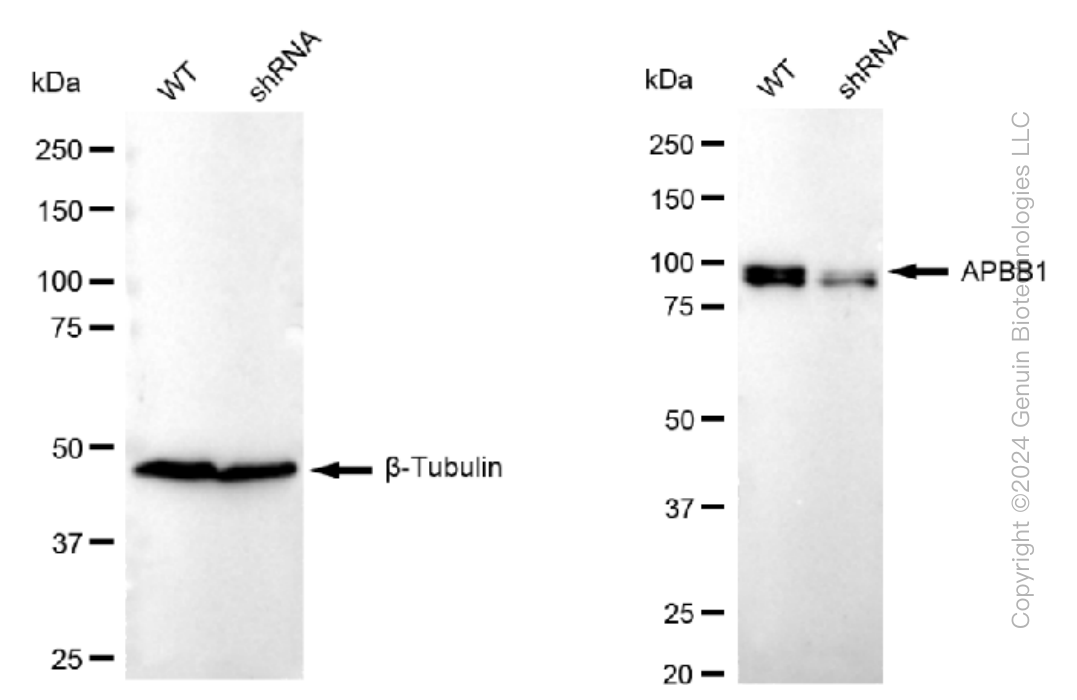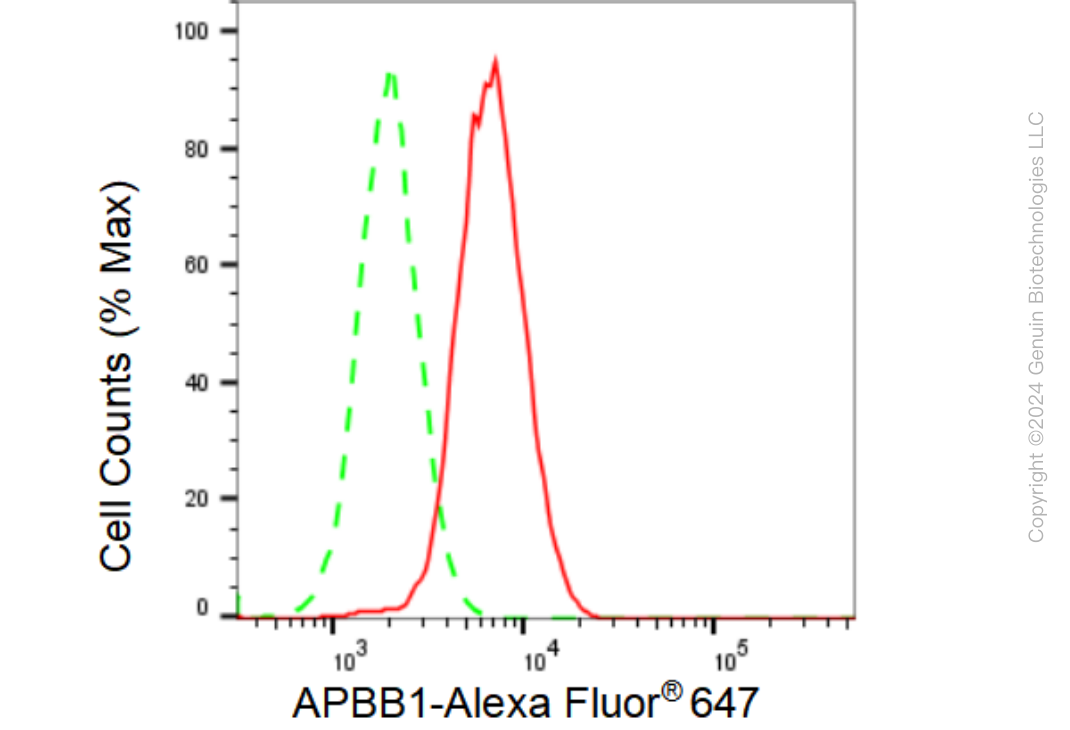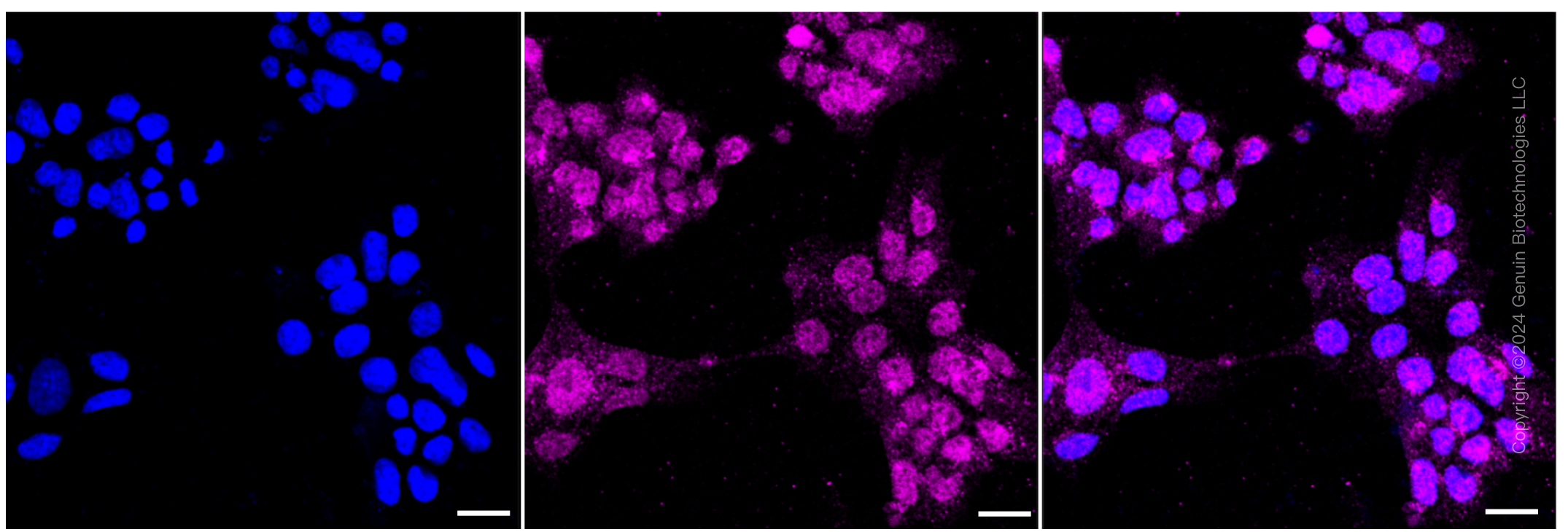KD-Validated Anti-APBB1 Rabbit Monoclonal Antibody
Rabbit monoclonal antibody
- SPECIFICATION
- CITATIONS
- PROTOCOLS
- BACKGROUND

Application
| WB, FC, ICC |
|---|---|
| Primary Accession | O00213 |
| Reactivity | Human |
| Clonality | Monoclonal |
| Isotype | Rabbit IgG |
| Clone Names | 23GB 3665 |
| Calculated MW | Predicted, 77 kDa, observed, 100 kDa |
| Gene Name | APBB1 |
| Aliases | APBB1; Amyloid Beta Precursor Protein Binding Family B Member 1; FE65; RIR; Amyloid Beta (A4) Precursor Protein-Binding, Family B, Member 1 (Fe65); Amyloid-Beta A4 Precursor Protein-Binding Family B Member 1; Adaptor Protein FE65a2; Stat-Like Protein; Protein Fe65; MGC:9072; Fe65 |
| Immunogen | A synthesized peptide derived from human FE65 |
| Gene ID | 322 |
|---|---|
| Other Names | Amyloid beta precursor protein binding family B member 1 {ECO:0000312|HGNC:HGNC:581}, Amyloid-beta A4 precursor protein-binding family B member 1, APBB1 (HGNC:581) |
| Name | APBB1 (HGNC:581) |
|---|---|
| Function | Transcription coregulator that can have both coactivator and corepressor functions (PubMed:15031292, PubMed:18468999, PubMed:18922798, PubMed:25342469, PubMed:33938178). Adapter protein that forms a transcriptionally active complex with the gamma-secretase- derived amyloid precursor protein (APP) intracellular domain (PubMed:15031292, PubMed:18468999, PubMed:18922798, PubMed:25342469). Plays a central role in the response to DNA damage by translocating to the nucleus and inducing apoptosis (PubMed:15031292, PubMed:18468999, PubMed:18922798, PubMed:25342469). May act by specifically recognizing and binding histone H2AX phosphorylated on 'Tyr-142' (H2AXY142ph) at double-strand breaks (DSBs), recruiting other pro-apoptosis factors such as MAPK8/JNK1 (PubMed:19234442). Required for histone H4 acetylation at double-strand breaks (DSBs) (PubMed:19234442). Its ability to specifically bind modified histones and chromatin modifying enzymes such as KAT5/TIP60, probably explains its transcription activation activity (PubMed:33938178). Functions in association with TSHZ3, SET and HDAC factors as a transcriptional repressor, that inhibits the expression of CASP4 (PubMed:19343227). Associates with chromatin in a region surrounding the CASP4 transcriptional start site(s) (PubMed:19343227). Involved in hippocampal neurite branching and neuromuscular junction formation, as a result plays a role in spatial memory functioning (By similarity). Plays a role in the maintenance of lens transparency (By similarity). May play a role in muscle cell strength (By similarity). Acts as a molecular adapter that functions in neurite outgrowth by activating the RAC1-ARF6 axis upon insulin treatment (PubMed:36250347). |
| Cellular Location | Cell membrane. Cytoplasm. Nucleus. Cell projection, growth cone {ECO:0000250|UniProtKB:P46933}. Nucleus speckle. Note=Colocalizes with TSHZ3 in axonal growth cone (By similarity). Colocalizes with TSHZ3 in the nucleus (PubMed:19343227). In normal conditions, it mainly localizes to the cytoplasm, while a small fraction is tethered to the cell membrane via its interaction with APP (PubMed:18468999). Following exposure to DNA damaging agents, it is released from cell membrane and translocates to the nucleus (PubMed:18468999). Nuclear translocation is under the regulation of APP (PubMed:18468999). Colocalizes with NEK6 at the nuclear speckles (PubMed:17512906). Phosphorylation at Ser-610 by SGK1 promotes its localization to the nucleus (By similarity) {ECO:0000250|UniProtKB:P46933, ECO:0000269|PubMed:17512906, ECO:0000269|PubMed:18468999, ECO:0000269|PubMed:19343227} |
| Tissue Location | Highly expressed in brain; strongly reduced in post-mortem elderly subjects with Alzheimer disease |

Thousands of laboratories across the world have published research that depended on the performance of antibodies from Abcepta to advance their research. Check out links to articles that cite our products in major peer-reviewed journals, organized by research category.
info@abcepta.com, and receive a free "I Love Antibodies" mug.
Provided below are standard protocols that you may find useful for product applications.
If you have used an Abcepta product and would like to share how it has performed, please click on the "Submit Review" button and provide the requested information. Our staff will examine and post your review and contact you if needed.
If you have any additional inquiries please email technical services at tech@abcepta.com.













 Foundational characteristics of cancer include proliferation, angiogenesis, migration, evasion of apoptosis, and cellular immortality. Find key markers for these cellular processes and antibodies to detect them.
Foundational characteristics of cancer include proliferation, angiogenesis, migration, evasion of apoptosis, and cellular immortality. Find key markers for these cellular processes and antibodies to detect them. The SUMOplot™ Analysis Program predicts and scores sumoylation sites in your protein. SUMOylation is a post-translational modification involved in various cellular processes, such as nuclear-cytosolic transport, transcriptional regulation, apoptosis, protein stability, response to stress, and progression through the cell cycle.
The SUMOplot™ Analysis Program predicts and scores sumoylation sites in your protein. SUMOylation is a post-translational modification involved in various cellular processes, such as nuclear-cytosolic transport, transcriptional regulation, apoptosis, protein stability, response to stress, and progression through the cell cycle. The Autophagy Receptor Motif Plotter predicts and scores autophagy receptor binding sites in your protein. Identifying proteins connected to this pathway is critical to understanding the role of autophagy in physiological as well as pathological processes such as development, differentiation, neurodegenerative diseases, stress, infection, and cancer.
The Autophagy Receptor Motif Plotter predicts and scores autophagy receptor binding sites in your protein. Identifying proteins connected to this pathway is critical to understanding the role of autophagy in physiological as well as pathological processes such as development, differentiation, neurodegenerative diseases, stress, infection, and cancer.





